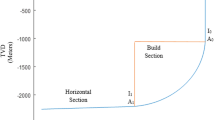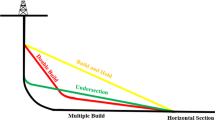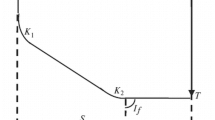Abstract
Due to a variety of possible good types and so many complex drilling variables and constraints, optimization of the trajectory of a complex wellbore is very challenging. There are several types of well such as directional wells, horizontal wells, redrilling wells, complex structure wells, cluster wells, and extended reach wells etcetera. Over the past few years, the number of unconventional well including deviated well, highly deviated well is steadily increasing. Directional drilling has some advantages over vertical drilling though it is more expensive. In drilling engineering optimization of wellbore plays an important role, which can be optimized based on the minimization of the length of wellbore, minimization of mud pressure, critical pressure etcetera. Till today so many approaches or methods used to optimize this wellbore trajectory. From those methods here in this study we focused on metaheuristic approaches that used to optimize wellbore trajectory. This reduction of the wellbore length helps to establish cost-effective approaches that can be utilized to resolve a group of complex trajectory optimization challenges. For efficient performance (i.e.; quickly locating global optima while taking the smallest amount of computational time) we have to identify flexible control parameters. Later this parameter can be effectively fixed to tune different algorithms. This research will develop a review of the various algorithm used to optimize deviated wellbore trajectories. In the environment of challenging commodity prices, engineers and commercial firms bound to utilize technology to find out a low-cost solution. Technology is also helpful for the automatic solution of a complex problem, which also allows for the better utilization of resources. This review paper helps to find out optimal wellbore trajectory optimization algorithms that can close the technology gap by giving a useful method. This method can generate a solution automatically. Before establishing a different algorithm, those previous authors considered a number of factors and limitations. Safety is one of them. Before drilling depleted zones should be well studied, otherwise, it may be the reason for so many problems. The heuristic approach builds up solutions through the trial and error method. Those methods take a decent amount of time for solving a complex problem. For a single known problem, different metaheuristic approaches take a different amount of time to find the optimal solution. Among different metaheuristic algorithm which was used to find minimum true measured depth (TMD), we try to make a review where we focused on their computational time, minimization of length, method, etcetera.













Similar content being viewed by others
Abbreviations
- A:
-
Curvature of the curve
- ABC:
-
Artificial bee colony
- ACO:
-
Ant colony optimization
- AI:
-
Artificial intelligence
- HS:
-
Harmonic search
- CCA:
-
Cheetah chase algorithm
- BFO:
-
Bat flight algorithm
- CSO:
-
Cuckoo search optimization
- D1, D2, D3:
-
Three segments for build and drop
- D KOP :
-
True vertical depth of kickoff point, M
- D v1 :
-
True vertical depth after at end of first hold section
- D v2 :
-
True vertical depth after at end of drop section, M
- DLS:
-
Dog leg severity
- EA:
-
Evolutionary algorithm
- FSQGA:
-
Frequency search quantum genetic algorithm
- GA:
-
Genetic algorithm
- GMMPR:
-
Global minimum mud pressure
- HCSO:
-
Hybrid cuckoo search method
- HD:
-
Horizontal section M
- HMCR:
-
Harmony memory considering rate
- HMS:
-
Harmony memory size
- KOP:
-
Kick of point
- MMPR:
-
Minimum mud pressure required
- MOGA:
-
Multi-objective genetic algorithm
- MR:
-
Mutation rate
- PSO:
-
Particle swarm optimization
- QGA:
-
Quantum genetic algorithm
- T:
-
Dogleg severity
- TD:
-
Torque and drag
- TMD:
-
True measured depth
- TVD:
-
True vertical depth
- \(\theta_{1}\) :
-
Azimuth angle at kickoff point, degrees
- \(\theta_{2}\) :
-
Azimuth angle at end of first build section, degrees
- \(\theta_{3}\) :
-
Azimuth angle at end of first hold section, degrees
- \(\theta_{4}\) :
-
Azimuth angle at end of drop section, degrees
- \(\theta_{5}\) :
-
Azimuth angle at end of second hold section, degrees
- \(\theta_{6}\) :
-
Azimuth angle at end of second build section, degree
- \(\varnothing_{1} \varnothing_{2} \varnothing_{3}\) :
-
First, second, and third hold angles, degrees
References
Dalzell J (2013) Conventional natural gas supply costs in Western Canada. Canadian Energy Research Institute
Pratt SJG (2004) A fresh angle on oil drilling. Geotimes 49(3):18–21
Joshi S (2003) Cost/benefits of horizontal wells. In: SPE western regional/AAPG Pacific section joint meeting, 2003: Society of Petroleum Engineers
Karimpour K, Zarghami R, Moosavian MA, Bahmanyar H (2016) New fuzzy model for risk assessment based on different types of consequences. Oil Gas Sci Technol-Revue d’IFP Energies nouvelles 71(1):17
Short JA (1993) Introduction to directional and horizontal drilling. Pennwell Corporation, Tulsa
Miska S, Skalle P (1981) Theoretical description of a new method of optimal program design. Soc Pet Eng J 21(4):425–434
Amara M, Martin B (1990) The offshore directional drilling advisor: an expert system for directional drilling optimization. In: SPE annual technical conference and exhibition, 1990: Society of Petroleum Engineers
Rampersad P, Hareland G, Pairintra T (1993) Drilling optimization of an oil or gas field. In: SPE eastern regional meeting, 1993: Society of Petroleum Engineers
Helmy MW, Khalaf F, Darwish TA (1998) Well design using a computer model. SPE Drill Complet 13(1):42–46
Shokir EEM, Emera MK, Eid SM, Wally AW (2004) A new optimization model for 3D well design. Oil Gas Sci Technol 59(3):255–266
Awal M, Khan M, Mohiuddin M, Abdulraheem A, Azeemuddin M (2001) A new approach to borehole trajectory optimisation for increased hole stability. In: SPE middle east oil show, 2001: Society of Petroleum Engineers
Vasant P, DeMarco A (2015) Handbook of research on artificial intelligence techniques and algorithms. Information Science Reference
Vasant P, Vasant P (2012) Meta-heuristics optimization algorithms in engineering. Business, Economics, and Finance, IGI Global, p 734
Guria C, Goli KK, Pathak AK (2014) Multi-objective optimization of oil well drilling using elitist non-dominated sorting genetic algorithm. Pet Sci 11(1):97–110
Atashnezhad A, Wood DA, Fereidounpour A, Khosravanian R (2014) Designing and optimizing deviated wellbore trajectories using novel particle swarm algorithms. J Nat Gas Sci Eng 21:1184–1204
Bianchi L, Dorigo M, Gambardella LM, Gutjahr WJ (2009) A survey on metaheuristics for stochastic combinatorial optimization. Nat Comput 8(2):239–287
Yang X-S (2009) Harmony search as a metaheuristic algorithm. In: Music-inspired harmony search algorithm. Springer, 2009, pp 1–14
Polya G (1945) How to solve it. Princeton University Press, New Jersey
Gallagher K, Sambridge M (1994) Genetic algorithms: a powerful tool for large-scale nonlinear optimization problems. Comput Geosci 20(7–8):1229–1236
Yang X-S (2010) Nature-inspired metaheuristic algorithms. Luniver Press, Bristol
Ahmed KA, El-Tayeb S, Dahab A, Khalf F (1999) 3D well design using computer optimization model. In: Symposium of SPE Egyptian section for computer application, Egypt
Mansouri V, Khosravanian R, Wood DA, Aadnoy BS (2015) 3-D well path design using a multi objective genetic algorithm. J Nat Gas Sci Eng 27:219–235
Wood DA (2016) Hybrid bat flight optimization algorithm applied to complex wellbore trajectories highlights the relative contributions of metaheuristic components. J Nat Gas Sci Eng 32:211–221
Kasravi J, Safarzadeh MA, Hashemi A (2017) A population-feedback control based algorithm for well trajectory optimization using proxy model. J Rock Mech Geotech Eng 9(2):281–290
Sha L, Pan Z (2018) FSQGA based 3D complexity wellbore trajectory optimization. Oil Gas Sci Technol-Revue d’IFP Energies nouvelles 73:79
Khosravanian R, Mansouri V, Wood DA, Alipour MR (2018) A comparative study of several metaheuristic algorithms for optimizing complex 3-D well-path designs. J Pet Explor Prod Technol 8(4):1487–1503
Suryanarayana PV, McCann RC, Rudolf RL, Rupani RA (1998) Mathematical technique improves directional well-path planning. Oil Gas J 96:57–63
Xiushan L, Zaihong S, Sen F (1997) Natural parameter method accurately calculates well bore trajectory. Oil Gas J 95(4):90–92
Adams N, Charrier T (1985) Drilling engineering: a complete well planning approach. Pennwell Corp, Tulsa
Dorigo M, Stützle T (2019) Ant colony optimization: overview and recent advances. In: Handbook of metaheuristics. Springer, 2019, pp 311–351
Darquennes D (2005) Implementation and applications of ant colony algorithms. Facultées Universitaires Notre-Dame de la Paix, Namur Institut d’Informatique, vol 40
Hu X-M, Zhang J, Li Y (2008) Orthogonal methods based ant colony search for solving continuous optimization problems. J Comput Sci Technol 23(1):2–18
Guan Z-C, Liu Y-M, Liu Y-W, Xu Y-Q (2016) Hole cleaning optimization of horizontal wells with the multi-dimensional ant colony algorithm. J Nat Gas Sci Eng 28:347–355
Socha K, Dorigo M (2008) Ant colony optimization for continuous domains. Eur J Oper Res 185(3):1155–1173
Blum C (2005) Ant colony optimization: introduction and recent trends. Phys Life Rev 2(4):353–373
Hatampour A, Razmi R, Sedaghat MH (2013) Improving performance of a neural network model by artificial ant colony optimization for predicting permeability of petroleum reservoir rocks. Middle East J Sci Res 13(9):1217–1223
Davis L (1991) Handbook of genetic algorithms. Van Nostrand Reinhold, New York
Reeves CR (1997) Genetic algorithms for the operations researcher. INFORMS J Comput 9(3):231–250
Sevaux M, Dauzère-Pérès S (2003) Genetic algorithms to minimize the weighted number of late jobs on a single machine. Eur J Oper Res 151(2):296–306
Pongcharoen P, Hicks C, Braiden P (2004) The development of genetic algorithms for the finite capacity scheduling of complex products, with multiple levels of product structure. Eur J Oper Res 152(1):215–225
Vijande J, Piñeiro MM, Mosteiro L, Legido JL (2003) Estimation of carbonate–alcohol interaction parameters for Nitta-Chao group contribution model: application of a genetic Algorithm. Fluid Phase Equilib 212(1–2):165–174
Poli R, Langdon WB (1998) Genetic programming with one-point crossover. In: Soft computing in engineering design and manufacturing. Springer, 1998, pp 180-189
Tate DM, Smith AE (1995) A genetic approach to the quadratic assignment problem. Comput Oper Res 22(1):73–83
Gen M, Cheng R, Lin L (2008) Network models and optimization: Multiobjective genetic algorithm approach. Springer, Berlin
Lin W-Y, Lee W-Y, Hong T-P (2003) Adapting crossover and mutation rates in genetic algorithms. J Inf Sci Eng 19(5):889–903
Xie L, Moran DP, Yan L, Mercado J (2012) Sophisticated software analysis system and use of torque/drag modeling for complex well operations increases operational efficiency. In: IADC/SPE drilling conference and exhibition, 2012: Society of Petroleum Engineers
Johancsik C, Friesen D, Dawson R (1984) Torque and drag in directional wells-prediction and measurement. J Petrol Technol 36(06):987–992
McCormick JE, Evans CD, Le J, Chiu T (2011) The practice and evolution of torque and drag reduction: theory and field results. In: International petroleum technology conference, 2011
Yasari E, Pishvaie MR, Khorasheh F, Salahshoor K, Kharrat R (2013) Application of multi-criterion robust optimization in water-flooding of oil reservoir. J Petrol Sci Eng 109:1–11
Haupt RL, Haupt SE (2004) Practical genetic algorithms. Wiley, New York
Sivanandam S, Deepa S (2007) Introduction to genetic algorithms. Springer, Berlin
Li A (2010) The operator of genetic algorithms to improve its properties. Mod Appl Sci 4(3):2010
Karaboga D (2005) An idea based on honey bee swarm for numerical optimization. Technical report-tr06, Erciyes University, Engineering Faculty, Computer…, 2005
Karaboga D, Basturk B (2007) A powerful and efficient algorithm for numerical function optimization: artificial bee colony (ABC) algorithm. J Global Optim 39(3):459–471
Karaboga D, Ozturk C (2011) A novel clustering approach: artificial Bee Colony (ABC) algorithm. Appl Soft Comput 11(1):652–657
Karaboga D, Gorkemli B (2014) A quick artificial bee colony (qABC) algorithm and its performance on optimization problems. Appl Soft Comput 23:227–238
Goldberg DE (1989) Genetic algorithms in search. Optim Mach Learn
Chakraborty P, Roy GG, Das S, Jain D, Abraham A (2009) An improved harmony search algorithm with differential mutation operator. Fundam Inform 95(4):401–426
Daham BFA, Mohammed N, Mohammed KS (2014) Parameter controlled harmony search algorithm for solving the four-color mapping problem. Int J Comput Inf Technol 3–6
Weyland D (2010) A rigorous analysis of the harmony search algorithm: how the research community can be misled by a “novel” methodology. Int J Appl Metaheuristic Comput 1(2):50–60
Padberg M (2012) Harmony search algorithms for binary optimization problems. In: Operations research proceedings 2011. Springer, 2012, pp 343–348
Lee KS, Geem ZW (2005) A new meta-heuristic algorithm for continuous engineering optimization: harmony search theory and practice. Comput Methods Appl Mech Eng 194(36–38):3902–3933
Kazakevičius R, Ruseckas J (2014) Lévy flights in inhomogeneous environments and 1/f noise. Physica A 411:95–103
Kennedy J, Eberhart R (1995) Particle swarm optimization. In: IEEE international of first conference on neural networks, Perth, Australia. IEEE Press
Kennedy J (1997) The particle swarm: social adaptation of knowledge. In: Proceedings of 1997 IEEE international conference on evolutionary computation (ICEC’97), 1997. IEEE, pp 303–308
Shi Y, Eberhart R (1998) A modified particle swarm optimizer. In: 1998 IEEE international conference on evolutionary computation proceedings. IEEE world congress on computational intelligence (Cat. No. 98TH8360), 1998. IEEE, pp 69–73
Ganesan T, Vasant P, Elamvazuthy I (2012) A hybrid PSO approach for solving non-convex optimization problems. Arch Control Sci 22(1):87–105
Eberhart RC, Hu X (1999) Human tremor analysis using particle swarm optimization. In: Proceedings of the 1999 congress on evolutionary computation-CEC99 (Cat. No. 99TH8406), 1999, vol 3. IEEE, pp 1927–1930
Xu R, Wunsch D II, Frank R (2007) Inference of genetic regulatory networks with recurrent neural network models using particle swarm optimization. IEEE/ACM Trans Comput Biol Bioinform 4(4):681–692
Xiao X, Dow ER, Eberhart R, Miled ZB, Oppelt RJ (2003) Gene clustering using self-organizing maps and particle swarm optimization. In: Proceedings international parallel and distributed processing symposium, 2003. IEEE
Han P, Huang Y, Jia Z-Z, Wang D-F, Li Y-L (2005) Mixed H/spl I. bar/2/H/spl I. bar//spl infin/optimal PID control for superheated steam temperature system based on PSO optimization. In: 2005 international conference on machine learning and cybernetics, 2005, vol 2. IEEE, pp 960–964
Sharma P, Khurana N (2013) Study of optimal path finding techniques. Int J Adv Technol 4(2):124–130
Onwunalu J (2010) Optimization of field development using particle swarm optimization and new well pattern descriptions. Stanford University
Pedersen MEH (2010) Tuning & simplifying heuristical optimization. University of Southampton
Mercer RE, Sampson J (1978) Adaptive search using a reproductive meta-plan. Kybernetes 7(3):215–228
Keane AJ (1995) Genetic algorithm optimization of multi-peak problems: studies in convergence and robustness. Artif Intell Eng 9(2):75–83
Meissner M, Schmuker M, Schneider G (2006) Optimized Particle Swarm Optimization (OPSO) and its application to artificial neural network training. BMC Bioinform 7(1):125
Pedersen MEH, Chipperfield AJ (2010) Simplifying particle swarm optimization. Appl Soft Comput 10(2):618–628
Huang L, Ding S, Yu S, Wang J, Lu K (2016) Chaos-enhanced Cuckoo search optimization algorithms for global optimization. Appl Math Model 40(5–6):3860–3875
Chandrasekar C (2013) “An optimized approach of modified bat algorithm to record deduplication. Int J Comput Appl 62(1):10–15
Nakamura RY, Pereira LA, Costa KA, Rodrigues D, Papa JP, Yang X-S (2012) BBA: a binary bat algorithm for feature selection. In: 2012 25th SIBGRAPI conference on graphics, patterns and images, 2012. IEEE, pp 291–297
Ramesh B, Mohan VCJ, Reddy VV (2013) Application of bat algorithm for combined economic load and emission dispatch. Int J Electr Eng Telecommun 2(1):1–9
Kabir MWU, Sakib N, Chowdhury SMR, Alam MS (2014) A novel adaptive bat algorithm to control explorations and exploitations for continuous optimization problems. Int J Comput Appl 94(13):15–20
Topal AO, Altun O, Yildiz YE (2015) Micro bat algorithm for high dimensional optimization problems. Int J Comput Appl 122(12):2015
Induja S, Eswaramurthy V (2016) Bat algorithm: an overview and its applications. Int J Adv Res Comput Commun Eng 5(1):448–451
Yang X-S, Deb S (2009). Cuckoo search via Lévy flights. In: 2009 World congress on nature & biologically inspired computing (NaBIC), 2009. IEEE, pp 210–214
Yang X-S, Deb S (2014) Cuckoo search: recent advances and applications. Neural Comput Appl 24(1):169–174
Yang X, Deb S (2010) Engineering optimisation by cuckoo search. Int J Math Model Numer Optim 1(4):330–343
Rajabioun R (2011) Cuckoo optimization algorithm. Appl Soft Comput 11(8):5508–5518
Chandrasekaran K, Simon SP (2012) Multi-objective scheduling problem: hybrid approach using fuzzy assisted cuckoo search algorithm. Swarm Evol Comput 5:1–16
Kanagaraj G, Ponnambalam S, Jawahar N (2013) A hybrid cuckoo search and genetic algorithm for reliability–redundancy allocation problems. Comput Ind Eng 66(4):1115–1124
Zineddine M (2015) Vulnerabilities and mitigation techniques toning in the cloud: a cost and vulnerabilities coverage optimization approach using Cuckoo search algorithm with Lévy flights. Comput Secur 48:1–18
Roy S, Chaudhuri SS (2013) Cuckoo search algorithm using Lévy flight: a review. Int J Mod Educ Comput Sci 5(12):10
Walton S, Hassan O, Morgan K, Brown M (2011) Modified cuckoo search: a new gradient free optimisation algorithm. Chaos Solitons Fractals 44(9):710–718
Singh GP, Singh A (2014) Comparative study of krill herd, firefly and cuckoo search algorithms for unimodal and multimodal optimization. Int J Intell Syst Appl Eng 2(3):26–37
Han K-H, Kim J-H (2000) Genetic quantum algorithm and its application to combinatorial optimization problem. In: Proceedings of the 2000 congress on evolutionary computation. CEC00 (Cat. No. 00TH8512), 2000, vol 2. IEEE, pp 1354–1360
Sha L, He Y (2012) A novel Bloch quantum genetic algorithm and its application of drilling parameters optimization. In: The international conference on engineering technology and economic management, 2012, pp 6–9
Acknowledgements
This research will be conducted under the Graduate Assistantship (GA) scheme of Universiti Teknologi Petronas and Department of Fundamental and Applied Sciences, University Teknologi Petronas.
Author information
Authors and Affiliations
Corresponding author
Ethics declarations
Conflict of interest
This is kindly to inform that there is no conflict of interest among all the authors.
Additional information
Publisher's Note
Springer Nature remains neutral with regard to jurisdictional claims in published maps and institutional affiliations.
Rights and permissions
About this article
Cite this article
Biswas, K., Vasant, P.M., Vintaned, J.A.G. et al. A Review of Metaheuristic Algorithms for Optimizing 3D Well-Path Designs. Arch Computat Methods Eng 28, 1775–1793 (2021). https://doi.org/10.1007/s11831-020-09441-1
Received:
Accepted:
Published:
Issue Date:
DOI: https://doi.org/10.1007/s11831-020-09441-1




